skip to main |
skip to sidebar
 Interesting tidbit about hefeweizens. I’ve thought for years that I don’t like Blue Moon, an American made Belgian Witt, or wheat beer. Turns out I don’t like it in bottles. On tap it’s great! I’ve also discovered over the years that I’ve only really liked hefeweizens that were brewed at the restaurant I drank them at. I thought maybe it was a matter of freshness, so some time last year I brewed one of my own. Mine was good, but didn’t have the full fruity character that is characteristic of a true hefe–often described as a taste of banana and clove. Then I re-read something in a brewing book about Germans rolling bottled hefe on the table before opening it to mix the yeast in. I tried it with mine. What a difference! There was the flavor I was missing! If only I had re-read that before we were half way through drinking the batch!
Interesting tidbit about hefeweizens. I’ve thought for years that I don’t like Blue Moon, an American made Belgian Witt, or wheat beer. Turns out I don’t like it in bottles. On tap it’s great! I’ve also discovered over the years that I’ve only really liked hefeweizens that were brewed at the restaurant I drank them at. I thought maybe it was a matter of freshness, so some time last year I brewed one of my own. Mine was good, but didn’t have the full fruity character that is characteristic of a true hefe–often described as a taste of banana and clove. Then I re-read something in a brewing book about Germans rolling bottled hefe on the table before opening it to mix the yeast in. I tried it with mine. What a difference! There was the flavor I was missing! If only I had re-read that before we were half way through drinking the batch!
I enjoy freelancing. It’s great to have the chance to work in bigger cities that truly support the arts, or for bigger organizations with more enthusiastic support than is to be found in Buffalo. I love meeting other professionals from around the country, picking up ideas from other drapers, and making friends who are all over the country working in our small but spread out profession. When I got to the Shakespeare Theatre in DC, I realized that I had worked at the Santa Fe Opera at the same time as one of the other drapers at the Shakespeare. She just looked at me, and without batting an eyelash said, “Of course you did, because there are only six people who work in theatre.” It often feels that way, when I travel to a new city only to discover that I’m working with 5 people I’ve already worked with before.The downside of freelancing is that, in the long term, it’s hard to feel like anyplace is home. For someone like me, who does have a home and more importantly a husband who is my real home, freelancing can start to wear me down. I’ve been gone for 5 months, and boy was it good to pull into the driveway and unload all my stuff for a good long time. (In case you're curious, “a good long time” is 9 months.)There’s a lot of other little stuff I started to miss while freelancing, like easily available internet, my own bed, and my many hobbies, most of which don’t fit on a plane or are too much to pack in the truck. I was thrilled to pick up my spinning wheel half way through the journey, but at this point it’s been 7 ½ months since I’ve brewed a batch of beer. I had been planning to brew a German maibock in time for May, but Studio Arena closed just when I would have started it.So after unloading the truck and kissing my husband hello, I cracked open a sweet stout from my last batch (Chris didn’t even make a dent in 5 gallons of beer over 5 months, so it was almost all still here waiting for me) and hit the books. I landed again on a recipe for a cherry stout, made some calls to locate frozen sour cherries at one of the local farm markets, and got to business.I’ve had Belgian ales and lambics that included cherries, but not a stout. This is probably not the sort of thing anyone will be serving me anytime soon, so if I want it (and I do!) I’ll have to make it myself.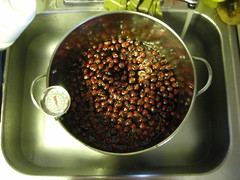 The cherries get added to the wort after the boil for long enough to pasteurize them, but the recipe (found in The Complete Joy of Homebrewing) cautions not to boil again with the cherries, or it will set the pectin and leave the beer with an unpleasant haze.The last two falls, I’ve brewed a pumpkin ale, which calls for boiling with the pumpkin, but then removing it before the wort goes into the fermenter. This recipe ferments with the cherries for the first five days to make the most of their fermentable sugars. They won’t actually add any sweetness to the final beer, because all the sugar will be used in the fermentation and converted to CO2 and alcohol. They will add their amazing sour cherry flavor, but I have no clear idea about how the final brew will taste.
The cherries get added to the wort after the boil for long enough to pasteurize them, but the recipe (found in The Complete Joy of Homebrewing) cautions not to boil again with the cherries, or it will set the pectin and leave the beer with an unpleasant haze.The last two falls, I’ve brewed a pumpkin ale, which calls for boiling with the pumpkin, but then removing it before the wort goes into the fermenter. This recipe ferments with the cherries for the first five days to make the most of their fermentable sugars. They won’t actually add any sweetness to the final beer, because all the sugar will be used in the fermentation and converted to CO2 and alcohol. They will add their amazing sour cherry flavor, but I have no clear idea about how the final brew will taste.  I was so excited about the cherries that I decided to feature them on the label. I often draw my labels while boiling the wort, but this one took a lot longer than that, probably longer than the actual brewing process. I hand draw my labels (as opposed to using photos or clip art or asking Chris to do it) because I like the look, but also because I never do any real drawings anymore, just quick working sketches, usually of sweaters on headless bodies. The labels keep me in practice. It’s not as much about keeping the skill sharp as about the kind of observation needed to draw something. Looking at something to draw it involves analysis, not of what it is, but of what it looks like, and HOW it looks that way. Not to look and let the brain say, "hey, that’s a round cherry," but to break down and reproduce the visual cues that the brain used to interpret that it’s round. I seldom look at things that way in any other part of life, because there’s no time and I rely on my brain’s interpretation skills to understand things quickly. Drawing something lets me slow down and look at that thing, live in the moment, and understand what I’m experiencing without short cuts or assumptions. It’s like (my limited understanding of) Buddhist mindfulness, or like the scene at the end of Our Town when Emily, after death, is given the chance to live one moment of her now finished life over again. This time she really experiences it and treasures it and pays attention and LIVES it. When she asks if anyone can ever go through life this way, she is told no not always, but sometimes poets and artists come close.Here’s what that has to do with beer (and don’t even think that was off track):
I was so excited about the cherries that I decided to feature them on the label. I often draw my labels while boiling the wort, but this one took a lot longer than that, probably longer than the actual brewing process. I hand draw my labels (as opposed to using photos or clip art or asking Chris to do it) because I like the look, but also because I never do any real drawings anymore, just quick working sketches, usually of sweaters on headless bodies. The labels keep me in practice. It’s not as much about keeping the skill sharp as about the kind of observation needed to draw something. Looking at something to draw it involves analysis, not of what it is, but of what it looks like, and HOW it looks that way. Not to look and let the brain say, "hey, that’s a round cherry," but to break down and reproduce the visual cues that the brain used to interpret that it’s round. I seldom look at things that way in any other part of life, because there’s no time and I rely on my brain’s interpretation skills to understand things quickly. Drawing something lets me slow down and look at that thing, live in the moment, and understand what I’m experiencing without short cuts or assumptions. It’s like (my limited understanding of) Buddhist mindfulness, or like the scene at the end of Our Town when Emily, after death, is given the chance to live one moment of her now finished life over again. This time she really experiences it and treasures it and pays attention and LIVES it. When she asks if anyone can ever go through life this way, she is told no not always, but sometimes poets and artists come close.Here’s what that has to do with beer (and don’t even think that was off track):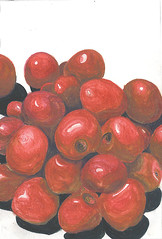 A fairly successful image of cherries. Because I was pleased, and loved the color theory involved, I also took a process picture to show the “underpainting” that I used to get the shadow colors. The cherry off to the right that looks like an olive shows only those colors, before I laid the red over the whole thing. I used water color pencils, so after drawing in the layers of color, I carefully painted over them with a wet brush to blend them and get a much richer color and more of a painted look.
A fairly successful image of cherries. Because I was pleased, and loved the color theory involved, I also took a process picture to show the “underpainting” that I used to get the shadow colors. The cherry off to the right that looks like an olive shows only those colors, before I laid the red over the whole thing. I used water color pencils, so after drawing in the layers of color, I carefully painted over them with a wet brush to blend them and get a much richer color and more of a painted look.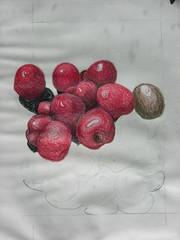 This has been a good technique for me, as I’ve always been much more confident drawing than painting.Right now the fermenting wort looks like this:
This has been a good technique for me, as I’ve always been much more confident drawing than painting.Right now the fermenting wort looks like this: No, not a fashion statement. Ale yeast ferments best between 60 and 75 degrees F. It has been a bit over that in the apartment, but I didn’t want to wait until September to brew, so I’m using a trick I read in The Homebrewer’s Recipe Guide, which is to put a wet tee shirt over your fermenter so that the evaporating water will cool it. It’s working well, and has brought my wort temp down from 82 deg to 77.
No, not a fashion statement. Ale yeast ferments best between 60 and 75 degrees F. It has been a bit over that in the apartment, but I didn’t want to wait until September to brew, so I’m using a trick I read in The Homebrewer’s Recipe Guide, which is to put a wet tee shirt over your fermenter so that the evaporating water will cool it. It’s working well, and has brought my wort temp down from 82 deg to 77.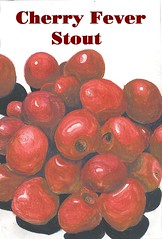
I love the colors in Noro yarn. especially the long fading repeats. Recently, I started seeing friends using Noro's sock yarn, which uses the same kind of long repeat, but weirdly provides three repeats in a ball. 3? Socks usually come in pairs, right? I get two size six socks out of 100 grams of sock yarn with a fair amount left over. Lots of folks get 2 pair out of 100 grams with little left over, and some can make it on 100 grams if they do a contrasting heal and toe. I don't see how 3 repeats in 100 grams helps any of us. Also, at $20 a ball I wasn't buying another just to get the pattern right. I figured each sock would take 1 1/4 to 1 1/2 repeats, so I sucked it up and knit the first sock, cut the yarn, and knit another the same size. This is what I got. Having been a first hand for 6 years, this drives me absolutely nuts. In a costume shop, the first hand assists the draper and is in charge of laying out and cutting the draper's clothing patterns. That means one of the few things that is solely the first hand's responsibility is pattern layout. Not just the dreaded matching of plaids that you read about in Judy Blume novels, but also matching florals, paisleys, etc and arranging bias stripes to chevron at seams or patterns to mirror themselves at center back and center front. That being said, a heavy stripe pattern being two inches off, like those two socks up there when worn next to each other, is way worse than if the two had nothing to do with eachother.
Having been a first hand for 6 years, this drives me absolutely nuts. In a costume shop, the first hand assists the draper and is in charge of laying out and cutting the draper's clothing patterns. That means one of the few things that is solely the first hand's responsibility is pattern layout. Not just the dreaded matching of plaids that you read about in Judy Blume novels, but also matching florals, paisleys, etc and arranging bias stripes to chevron at seams or patterns to mirror themselves at center back and center front. That being said, a heavy stripe pattern being two inches off, like those two socks up there when worn next to each other, is way worse than if the two had nothing to do with eachother.
I couldn't take it, but weirdly enough, for my little feet each sock took slightly less than a full repeat, so I picked the placement I preferred (the second sock I knit, which is the one on the left in the picture) and I started from the same spot in the pattern repeat and knitted a third sock.
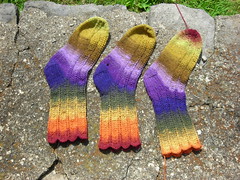 Now, if the aliens land on a rainy day and get a soaker on their way from their ship to my door, I can offer a trio of dry socks, helpful to any tri-pedal alien who wears a woman's size six. It felt weird to still be knitting the same pair of socks after I had already finished 2, but look how much better this pair looks:
Now, if the aliens land on a rainy day and get a soaker on their way from their ship to my door, I can offer a trio of dry socks, helpful to any tri-pedal alien who wears a woman's size six. It felt weird to still be knitting the same pair of socks after I had already finished 2, but look how much better this pair looks: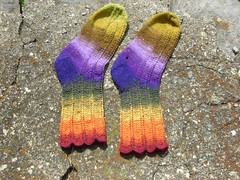 Now I can wear them in front of my first hand without shame, and can still hear what Chris is saying to me while I'm wearing them. much better.
Now I can wear them in front of my first hand without shame, and can still hear what Chris is saying to me while I'm wearing them. much better.










